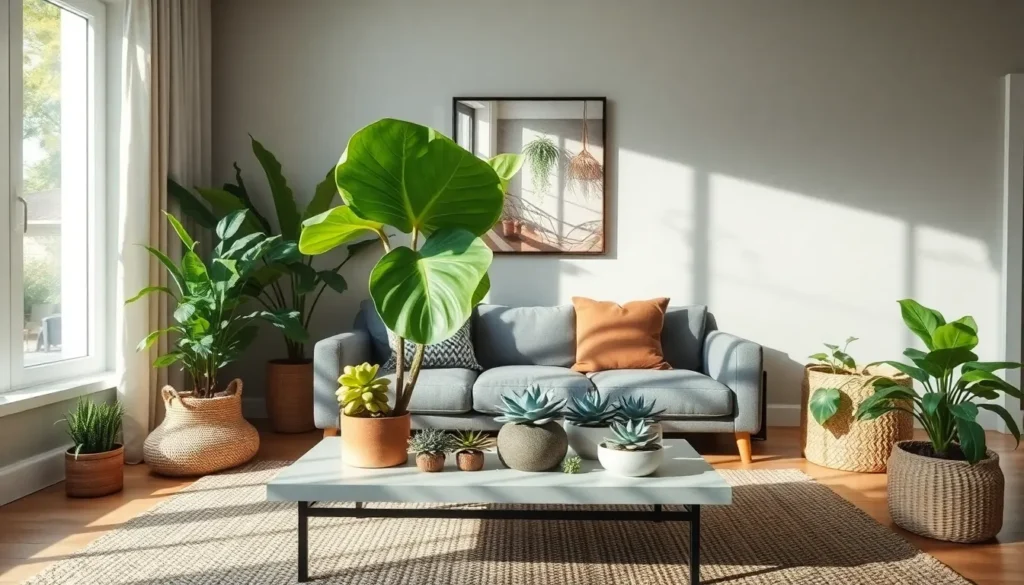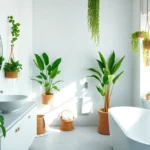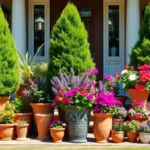We’ve all experienced that moment when we walk into a living room and instantly feel drawn to its warmth and vitality. More often than not indoor plants are the secret ingredient that transforms an ordinary space into something extraordinary. These living decorations don’t just add color and texture – they breathe life into our homes while purifying the air we breathe.
Indoor plant decor has become one of the most powerful tools in modern interior design and for good reason. Whether you’re working with a minimalist aesthetic or a maximalist approach your living room can benefit from the natural beauty that plants provide. From towering fiddle leaf figs that command attention to delicate trailing pothos that soften harsh corners the right plants can completely reshape how your space feels and functions.
We’re here to show you exactly how to harness the groundbreaking power of indoor plants to create a living room that’s not just beautiful but genuinely alive with personality and style.
Choose the Right Indoor Plants for Your Living Room Decor
Selecting the perfect indoor plants for your living room transforms your space while ensuring long-term success with your green companions. We’ll guide you through three essential factors that determine which plants thrive in your exact environment.
Consider Light Requirements and Room Conditions
Assess your living room’s natural light patterns before choosing any plants. South-facing windows provide bright, direct sunlight perfect for succulents like jade plants and snake plants. East and west-facing rooms offer moderate light ideal for pothos, philodendrons, and rubber trees. North-facing spaces with low light conditions work best for ZZ plants, peace lilies, and Chinese evergreens.
Measure your room’s humidity levels using a simple hygrometer to match plants with appropriate moisture needs. Most tropical plants like monstera and fiddle leaf figs prefer 40-60% humidity, while desert plants such as aloe vera and cacti thrive in drier conditions below 40%. Air circulation also affects plant health, so avoid placing delicate ferns near heating vents or air conditioning units.
Temperature consistency plays a crucial role in plant selection for living rooms. Most houseplants prefer temperatures between 65-75°F during the day and 60-70°F at night. Avoid dramatic temperature fluctuations near windows, fireplaces, or HVAC systems that can stress plants like Boston ferns and orchids.
Select Plants That Match Your Maintenance Level
Low maintenance plants suit busy lifestyles and beginner plant parents perfectly. Snake plants, ZZ plants, and pothos require watering only every 2-3 weeks and tolerate neglect exceptionally well. These resilient options forgive missed watering schedules and irregular care routines.
Moderate maintenance plants need weekly attention but reward you with faster growth and more dramatic displays. Fiddle leaf figs, monstera deliciosa, and rubber plants require consistent watering schedules and occasional leaf cleaning. These plants respond well to regular fertilizing during growing seasons.
High maintenance plants demand daily or every-other-day attention but create stunning focal points in living rooms. Calatheas, ferns, and orchids need exact humidity levels, filtered water, and precise care schedules. These plants work best for experienced plant enthusiasts who enjoy hands-on gardening.
Pick Plants That Complement Your Interior Style
Modern minimalist living rooms benefit from clean-lined plants with architectural forms. Snake plants, ZZ plants, and single-stem fiddle leaf figs create striking vertical elements without overwhelming sleek furniture. Choose plants with simple, geometric shapes that echo your room’s contemporary aesthetic.
Bohemian and eclectic spaces embrace lush, trailing plants that add organic texture and movement. Hanging pothos, string of hearts, and spider plants create cascading green curtains from shelves and macrame hangers. Mix different leaf shapes and sizes to achieve that relaxed, collected-over-time appearance.
Traditional and classic interiors pair beautifully with elegant plants in sophisticated containers. Peace lilies, parlor palms, and Boston ferns in decorative ceramic or brass planters enhance formal living rooms. These plants provide refined greenery without disrupting timeless design elements.
Scandinavian and rustic styles complement plants with natural, understated beauty. Eucalyptus, olive trees, and herbs like rosemary bring organic simplicity to wood and neutral color schemes. Choose plants in natural materials like terracotta, wood, or woven baskets to maintain cohesive styling.
Position Plants Strategically for Maximum Visual Impact
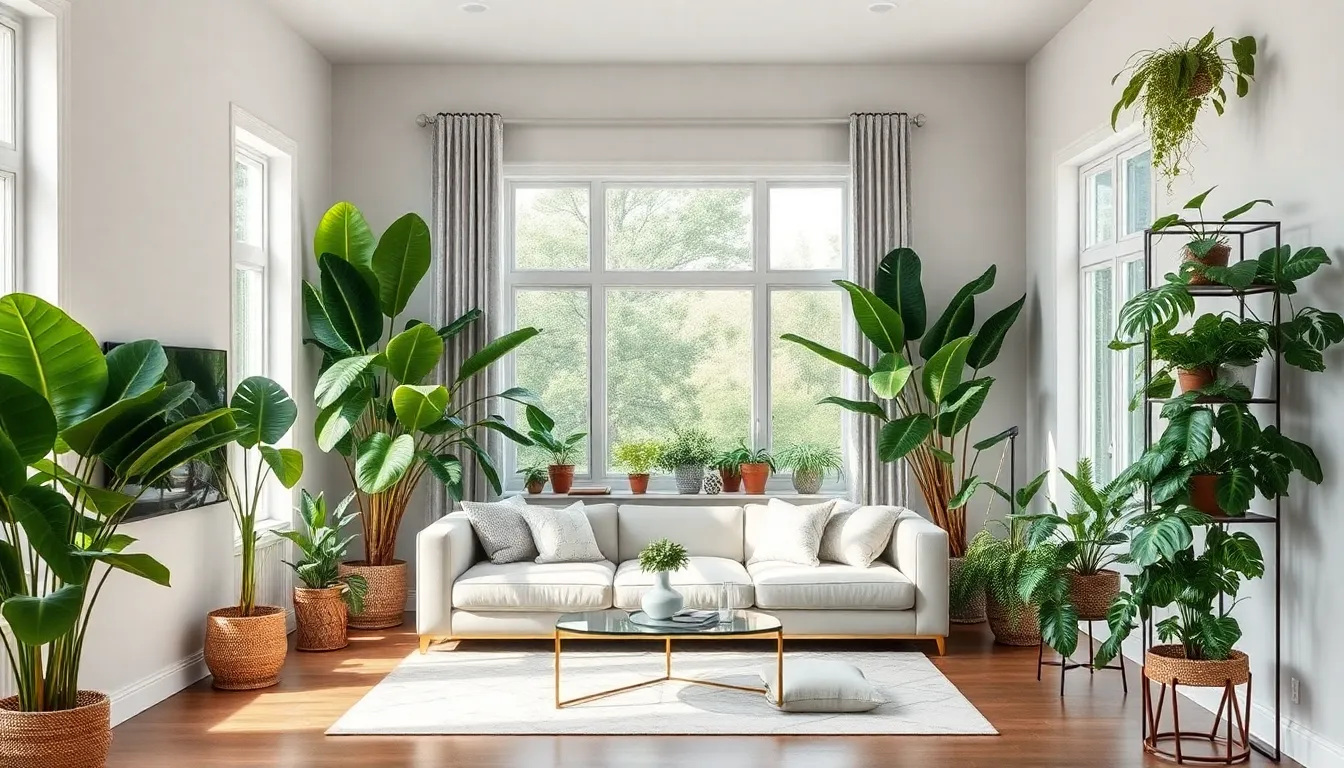
Once we’ve selected our plants, their placement becomes crucial for creating a stunning living room atmosphere. Strategic positioning transforms ordinary spaces into vibrant, visually appealing environments that showcase our greenery effectively.
Create Focal Points with Statement Plants
Statement plants command attention and serve as natural conversation starters in our living rooms. Tall fiddle leaf figs work exceptionally well as room dividers while maintaining an open feel throughout the space. These sculptural beauties can reach impressive heights and create dramatic vertical lines that draw the eye upward.
Monstera plants offer another excellent focal point option with their distinctive split leaves and architectural presence. We can position these showstoppers near windows where they receive adequate light while becoming the centerpiece of our decor. Large leafed varieties like Umbrella Plants and Areca Palms also make striking focal points due to their bold foliage and substantial size.
Pruning plays a vital role in maintaining our statement plants’ visual impact. When tall indoor trees approach ceiling height, strategic pruning encourages fuller branching patterns that enhance their sculptural qualities without overwhelming our living space.
Use Corner Spaces for Dramatic Effect
Empty corners present perfect opportunities for creating dramatic plant displays that transform dead zones into lively focal areas. Large floor plants positioned in corners use space efficiently while adding greenery at eye level or higher, creating natural vertical interest throughout our room.
Corner placement works particularly well for tall plants like Areca Palms and fiddle leaf figs, which can grow upward without interfering with furniture arrangements or foot traffic patterns. These strategic positions allow plants to “breathe” while maximizing their visual impact.
Hanging plants and tiered plant shelves in corners create additional dimension by drawing our eyes upward and establishing layers of greenery. String of Pearls and other trailing varieties work beautifully in elevated corner positions, adding elegance and movement to otherwise static spaces.
Balance Plant Placement Throughout the Room
Achieving visual harmony requires distributing plants evenly across different surfaces and elevations within our living room. We should vary plant heights by combining tall floor specimens with medium plants on furniture and small varieties on tables or in hanging baskets.
Grouping plants in odd numbers creates naturally attractive clusters that feel more organic than even numbered arrangements. Small plants work particularly well when arranged in groups of three or five on coffee tables, shelves, or plant stands.
Surface distribution helps maintain visual balance without creating clutter. Floor plants anchor our arrangement, while table plants like succulents and aloe provide intimate details at conversation level. Wall mounted or ceiling hung plants complete the layered effect by utilizing vertical space effectively.
Proper spacing between plants and furniture ensures each specimen has adequate room for growth while maintaining clean sight lines throughout our living room. This balanced approach creates a cohesive, inviting atmosphere that enhances our home’s natural beauty.
Select Stylish Planters That Enhance Your Living Room Aesthetic
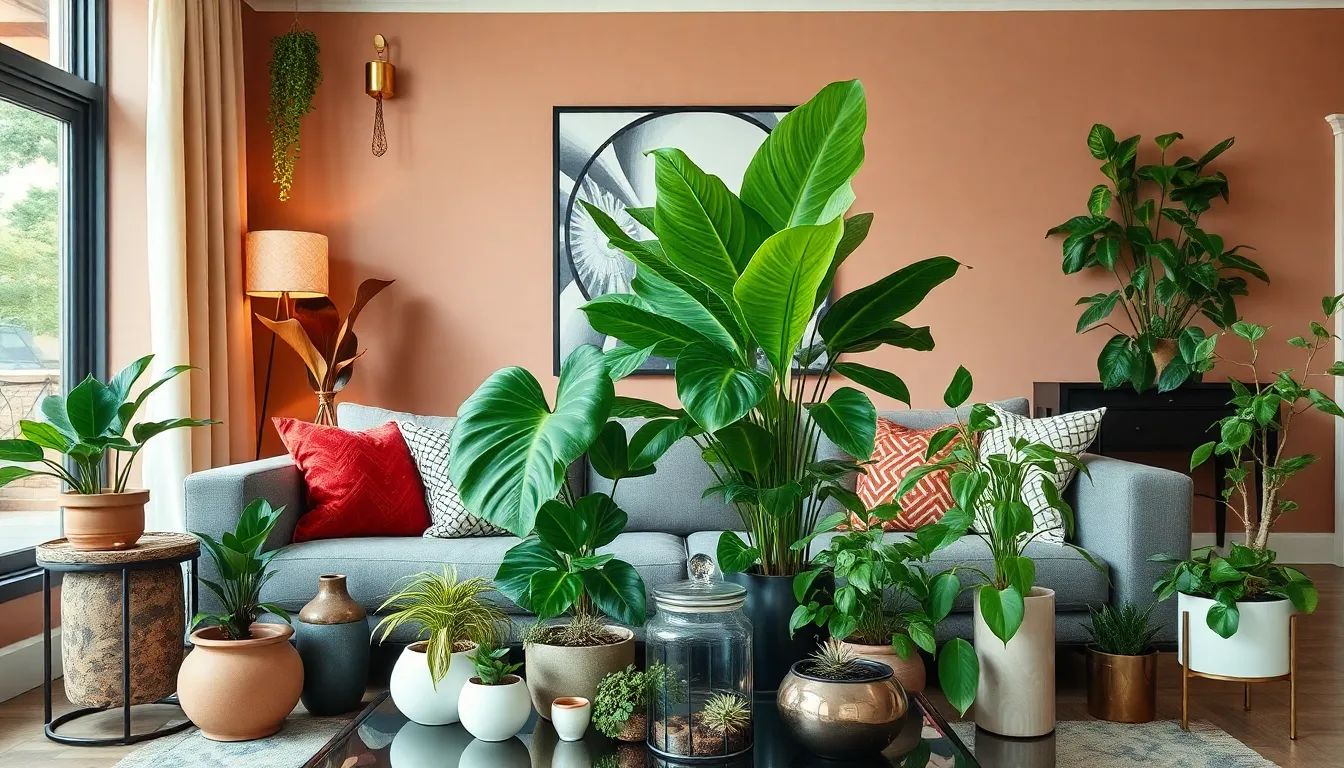
The right planters transform your green friends from simple houseplants into stunning decor elements that define your space’s personality. We’re diving into the art of selecting containers that don’t just hold soil and roots but elevate your entire living room aesthetic.
Match Planter Materials to Your Decor Theme
Terracotta and ceramic pots create the perfect foundation for rustic or boho-themed living rooms. These natural materials bring warmth and texture that complements woven throws, wooden furniture, and earthy color palettes beautifully.
Sleek metal planters and glass containers enhance modern minimalist interiors with their clean lines and reflective surfaces. Stainless steel, copper, or black metal options add sophisticated contrast against neutral walls and contemporary furniture pieces.
Woven baskets and natural fiber planters fit seamlessly into cozy farmhouse or eclectic living spaces. Materials like jute, rattan, and seagrass introduce organic textures that soften hard surfaces and create visual interest.
Mixing materials like vintage glass jars with terracotta pots adds ever-changing layers to your plant displays. This approach prevents monotony while maintaining cohesion through strategic color coordination and consistent plant care routines.
Choose Appropriate Sizes for Different Plant Types
Large plants like fiddle leaf figs and monsteras require substantial planters that anchor spacious corners effectively. These statement pieces need containers measuring 12-16 inches in diameter to accommodate their extensive root systems and provide visual stability.
Smaller plants including succulents and pothos thrive in compact planters perfect for shelves, coffee tables, and plant stands. Containers ranging from 4-8 inches work ideally for these varieties while maintaining proper drainage and root space.
Grouping plants by size creates visual layers that add dimension to your living room layout. Arrange tall plants in the background, medium plants in the middle ground, and small plants in the foreground to establish natural depth and movement.
Hanging planters maximize vertical space without overwhelming smaller living rooms. Wall-mounted shelves and ceiling hooks expand your plant display options while maintaining floor space for furniture and foot traffic.
Consider Decorative Pots vs. Functional Containers
Decorative pots prioritize aesthetics with unique designs, colors, and finishes that complement your living room’s style. These containers often feature artistic elements like hand-painted patterns, textured surfaces, or metallic accents that serve as conversation pieces.
Functional containers focus on plant health through proper drainage holes and durable materials. These practical options ensure your plants receive adequate water management and root aeration for long-term growth and vitality.
Combining both approaches allows you to maintain plant wellness while improving room aesthetics. Place functional nursery pots inside decorative outer containers to achieve this balance without compromising plant care requirements.
Vintage vessels and thrifted trunks offer distinctive character that mass-produced planters can’t match. These one-of-a-kind finds create focal points while telling stories that reflect your personal style and collecting adventures.
Incorporate Hanging Plants for Vertical Interest
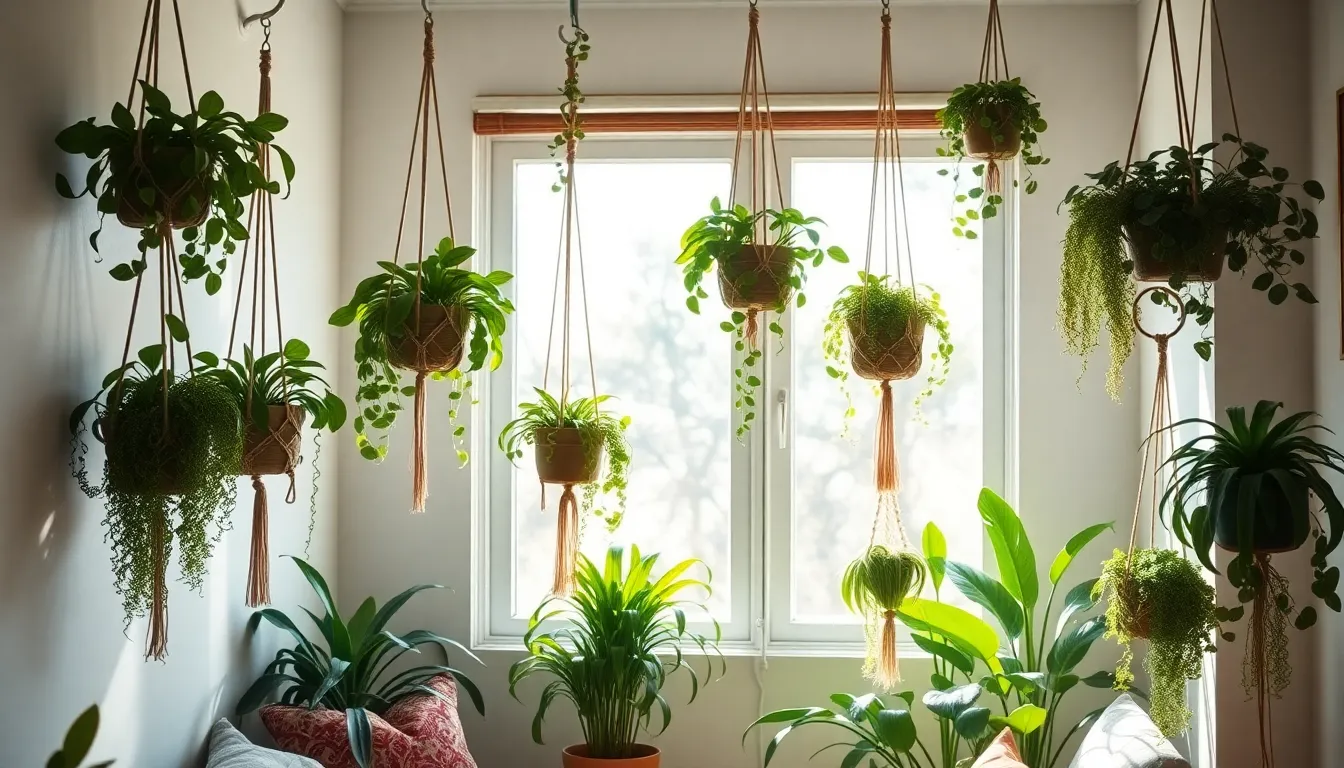
Hanging plants transform our living spaces by bringing nature into the airspace above, creating visual depth and dimension that draws the eye upward. These suspended beauties free up valuable floor and surface space while adding lush, cascading greenery that enhances any room’s ambiance.
Install Ceiling Hooks for Trailing Plants
Installing ceiling hooks provides the sturdy foundation we need to safely suspend our favorite trailing plants throughout the living room. We’ll want to locate ceiling joists or use appropriate anchors that can support the weight of both the planter and fully watered soil. Popular trailing varieties like pothos and string of pearls create elegant cascading displays when hung from these secure mounting points.
Ceiling installation works especially well in smaller living rooms where floor space comes at a premium. The technique allows us to maximize vertical real estate while keeping walkways clear and functional. We can position hooks at varying heights to create ever-changing displays that add movement and flow to our interior design.
Use Wall-Mounted Planters for Space-Saving Answers
Wall-mounted planters serve as living art pieces that maintain greenery at eye level without cluttering our shelves or tables. These space-saving answers work particularly well for compact living rooms where every square foot matters. We can arrange multiple wall planters in geometric patterns or asymmetrical groupings to create striking focal points.
Modern wall-mounted systems often include built-in drainage and modular components that let us expand our plant display over time. Plants positioned at eye level or higher become conversation starters while contributing to the room’s overall aesthetic appeal. This mounting approach combines functionality with decor, giving us maximum impact from our indoor plant investments.
Create Layered Heights with Macrame Hangers
Macrame hangers add handcrafted texture while allowing us to group plants at varied heights throughout our living space. These woven holders enhance the boho-chic aesthetic and create visual interest through their intricate patterns and natural materials. We can suspend multiple macrame planters at different lengths to achieve the layered jungle effect that’s become increasingly popular in modern interior design.
Plant grouping with macrame holders diversifies both textures and shapes in our living room displays. The technique works exceptionally well when we combine different trailing varieties, creating cascading greenery at multiple levels. This layered approach transforms empty corners and underutilized wall space into lush, three-dimensional garden features that bring life and movement to our home.
Design Plant Groupings for Cohesive Living Room Decor
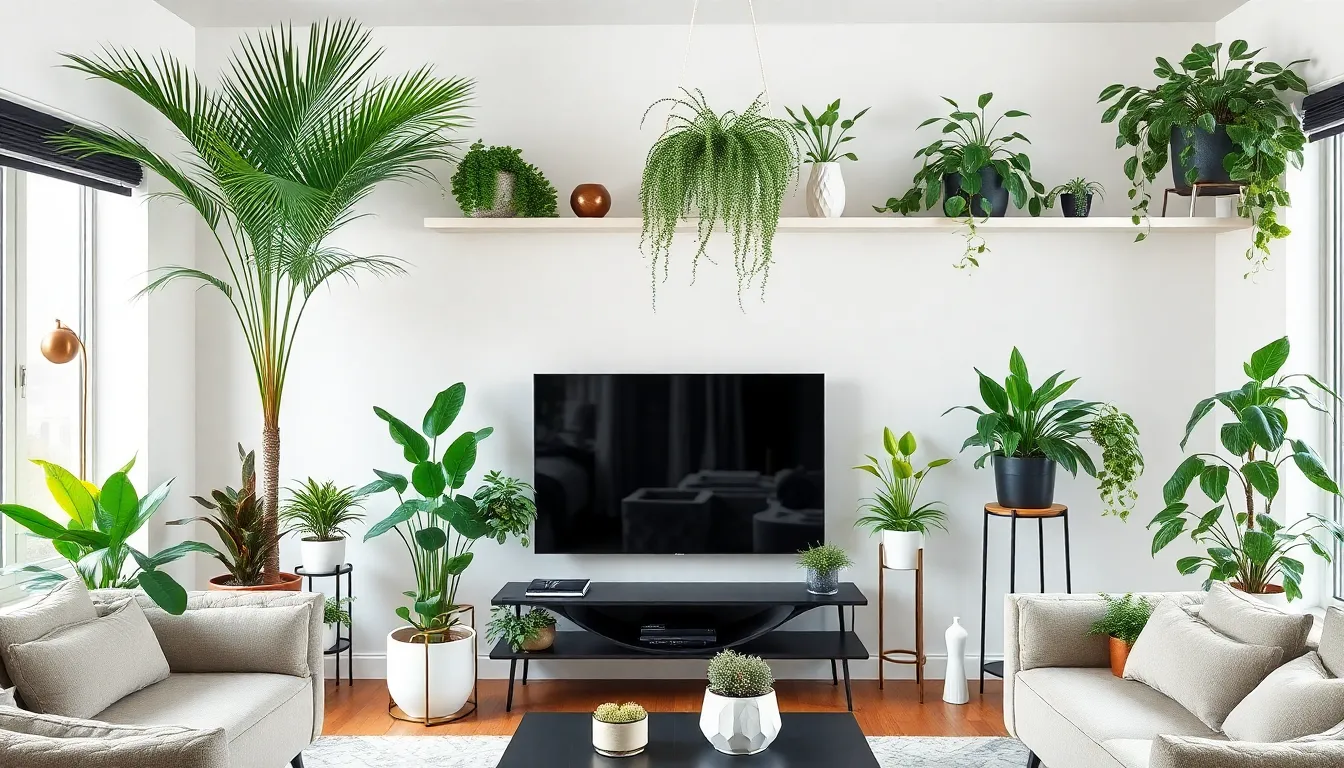
Creating thoughtful plant groupings transforms scattered greenery into a unified, lush look that feels intentional and visually stunning. Strategic clustering on corners, shelves, or plant stands establishes compelling focal points that complement your interior style perfectly.
Arrange Plants in Odd Numbers for Visual Appeal
Grouping plants in odd numbers creates more natural and ever-changing displays than even arrangements. Three or five plants together encourage the eye to move around the arrangement while providing balanced yet interesting visual flow. This asymmetrical approach mimics nature’s organic patterns and makes your living room plant collections feel more authentic.
We’ve found that triangular arrangements work exceptionally well, with the tallest plant positioned at the back and shorter varieties flanking the front. Five plant groupings allow for more complex layering, where you can create depth by varying both height and positioning. The odd number rule applies whether you’re working with identical plants or mixing different varieties throughout your space.
Mix Different Plant Heights and Textures
Combining plants of varying heights and leaf textures adds remarkable depth and dimension to your decor. Tall, leafy plants like the Areca Palm paired with trailing varieties such as String of Pearls create stunning layered effects that draw attention upward. Textural contrast between smooth, broad leaves and fine, spiky foliage enriches the visual appeal significantly.
We recommend starting with a statement plant as your anchor piece, then building around it with medium height plants and cascading varieties. Bushy plants like the Umbrella Plant (Schefflera) provide excellent middle ground height while offering fast growing, low maintenance appeal. Ground level plants such as Snake Plants or ZZ Plants complete the composition by filling lower visual space.
Consider leaf shapes when mixing textures: round leaves from Pothos complement the architectural lines of Snake Plants beautifully. Feathery palm fronds create striking contrast against the glossy leaves of Peace Lilies, while trailing plants soften hard edges throughout your arrangement.
Create Themed Collections by Color or Style
Focusing on exact color schemes or plant types allows you to personalize your plant decor while maintaining visual cohesion. All green foliage collections create calming, monochromatic vibes that work exceptionally well in minimalist living rooms. Plants with colorful leaves add vibrancy and can complement existing accent colors in your decor.
Matching planters in color or material unifies the look and adds important charm to your arrangements. Terracotta pots create warm, earthy themes that pair beautifully with rustic or bohemian decor styles. Vintage containers or coordinated ceramic planters in matching colors tie diverse plant varieties together seamlessly.
We suggest selecting plants that thrive in similar conditions when creating themed collections, ensuring your groupings remain healthy and beautiful long term. Low maintenance plants like Pothos, Snake Plants, ZZ Plants, and Peace Lilies work wonderfully together since they all prefer indirect light and similar watering schedules.
Integrate Plants with Existing Furniture and Decor
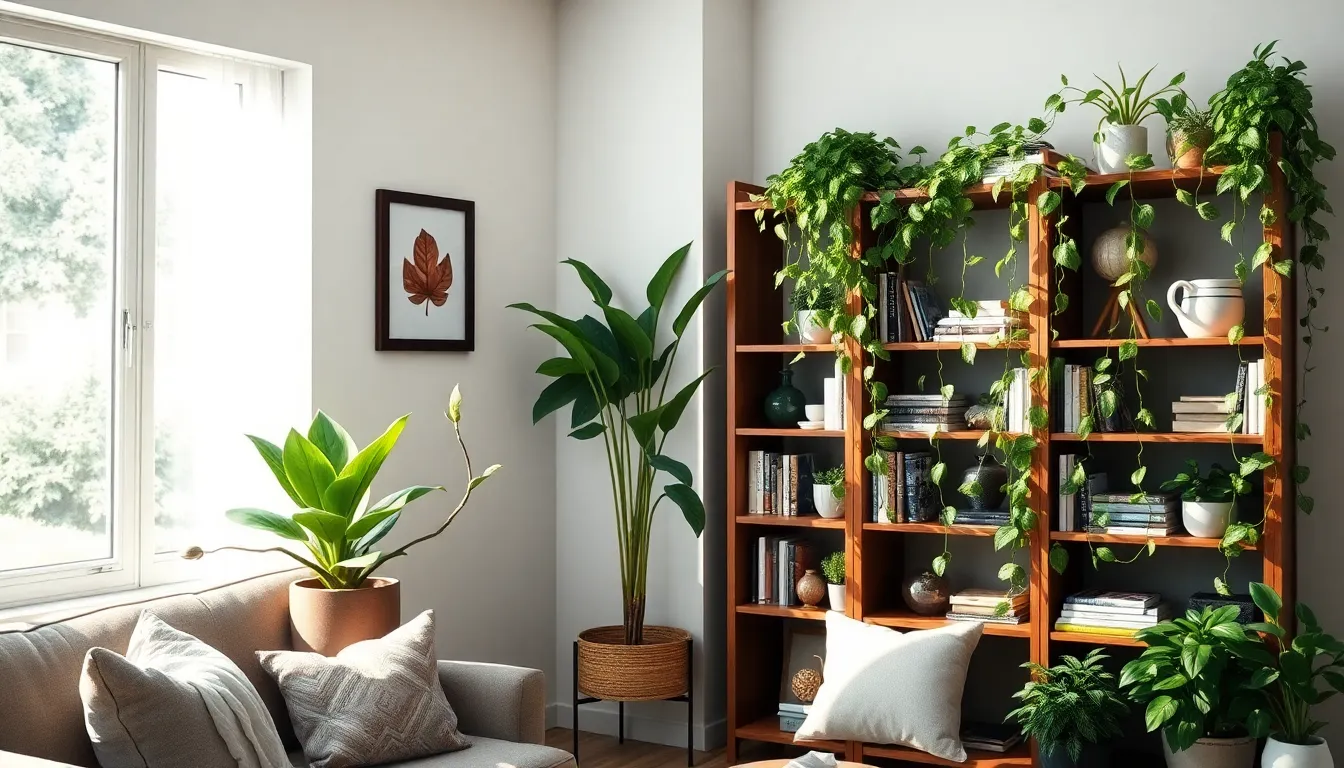
Creating a cohesive living room design means blending your plants seamlessly with your existing furniture pieces and decorative elements. Positioning greenery strategically near sofas, coffee tables, and side tables helps establish visual connections that make plants feel intentional rather than randomly placed throughout the space.
Use Plant Stands to Elevate Smaller Plants
Plant stands transform compact greenery into impressive design statements by adding crucial height variation to your living room layout. Elevated positioning showcases smaller plants more effectively, especially when placed in corners or beside seating areas where they can create dramatic visual layers.
Tall stands and decorative stools work particularly well for displaying petite plants that might otherwise get lost among larger furniture pieces. Varying the heights of multiple plant stands creates dimension and draws the eye upward, making your ceiling appear higher while adding sophisticated depth to the overall room design.
Corner placement using elevated stands maximizes underutilized spaces while creating stunning focal points that complement your existing furniture arrangement. These strategic positioning choices ensure your smaller plants receive proper visibility and contribute meaningfully to the room’s aesthetic appeal.
Incorporate Plants into Bookshelf Arrangements
Bookshelf integration softens the rigid lines of books and decorative objects while bringing natural vitality to these organized spaces. Trailing plants like pothos work exceptionally well when placed on higher shelves, allowing their vines to cascade naturally between book spines and creating beautiful organic movement.
Compact varieties such as snake plants fit perfectly into attractive pots that can be nestled between books without overwhelming the shelf’s organizational structure. Strategic placement breaks up the monotony of uniform book rows while maintaining the functional aspects of your storage display.
Mixing plants with existing decor items creates balanced visual weight across your shelving units, ensuring no single shelf appears too heavy or sparse. The combination of natural greenery with books and decorative accessories transforms static storage into ever-changing living displays that enhance your room’s personality.
Place Plants Near Windows for Natural Light Display
Window placement ensures your plants receive adequate natural light while creating beautiful silhouettes that enhance your living room’s visual appeal throughout different times of day. South facing and east facing windows provide ideal conditions for light loving plants, supporting their health while showcasing their natural beauty.
Indirect light near north facing windows suits plants like peace lilies and ZZ plants, allowing you to maintain thriving greenery even in spaces with limited direct sunlight exposure. Positioning plants near windows also creates natural frames that draw attention to both the outdoor view and your indoor garden display.
Optimal light exposure promotes healthy plant growth while the strategic window placement creates stunning backlit effects during golden hour, transforming your plants into living art pieces. Container selection becomes especially important in these prominent positions, as matching pots to your window treatments and nearby furniture maintains design continuity throughout the space.
Maintain Your Indoor Plant Decor for Long-Term Success
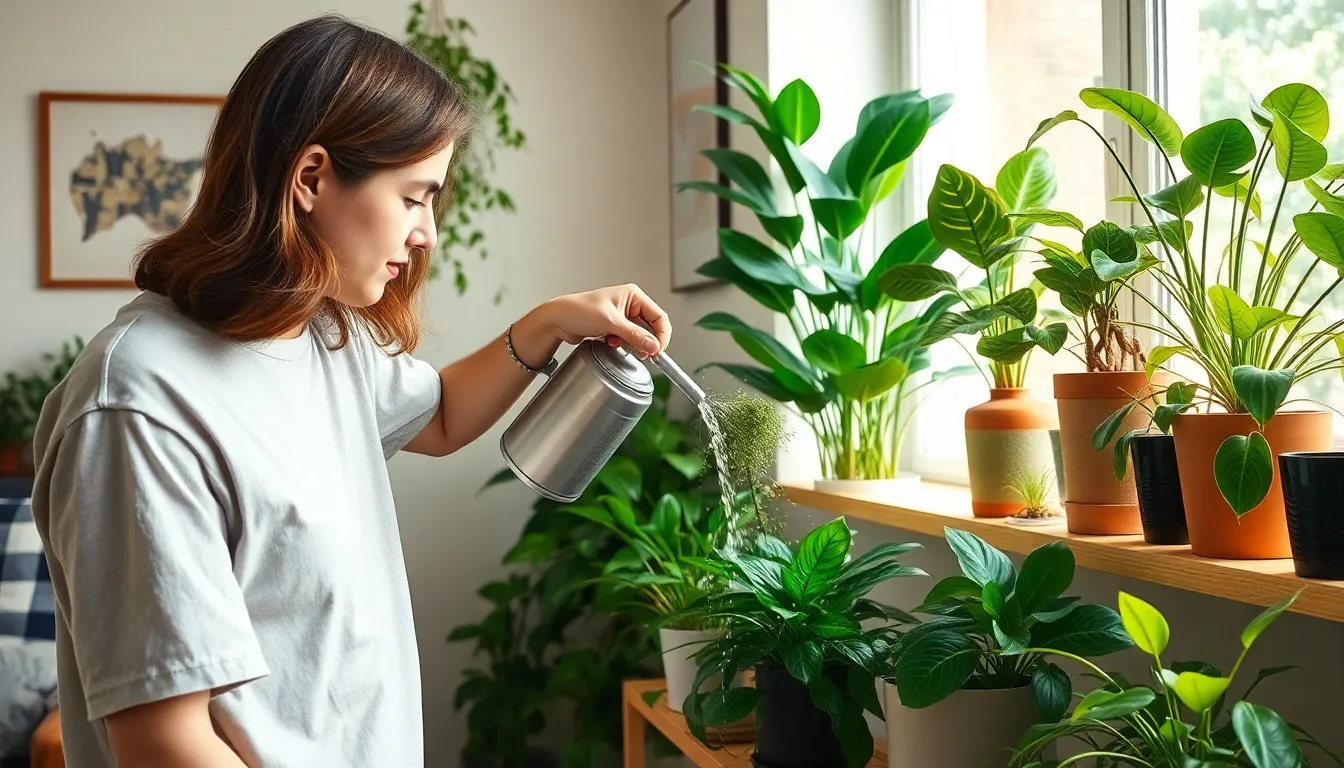
Consistency in plant care transforms your living room greenery from a temporary decoration into a thriving, permanent feature. Regular maintenance ensures your indoor plant decor continues improving your space for years to come.
Establish a Regular Watering and Care Schedule
Creating a consistent watering routine prevents the most common plant care mistakes that can ruin your living room decor. We recommend checking each plant’s exact water requirements since different species like pothos, snake plants, ZZ plants, and peace lilies have varying moisture needs.
Overwatering kills more indoor plants than underwatering, so we suggest establishing a weekly check rather than daily watering. Test the soil moisture by inserting your finger one inch deep into the potting mix before adding water.
Monitor your plants for signs of stress such as yellowing leaves, brown tips, or wilting to adjust your care schedule accordingly. Keep a simple plant care journal or use phone reminders to track watering dates and observe plant health changes over time.
Rotate Plants for Even Growth and Health
Turning your plants regularly ensures balanced growth and prevents them from leaning toward light sources like windows. We recommend rotating each plant a quarter turn every week to promote even development on all sides.
Plants naturally grow toward their light source, creating lopsided appearances that can detract from your carefully arranged living room decor. Regular rotation maintains the symmetrical shape that looks best in grouped arrangements and prevents unsightly stretching.
Pay special attention to plants positioned near windows or under grow lights, as these specimens show the most dramatic leaning tendencies. Rotate larger floor plants like fiddle leaf figs and monsteras more frequently since their size makes uneven growth more noticeable in your living space.
Replace or Refresh Plants as Needed
Removing dead or unhealthy plants immediately maintains the fresh, vibrant look of your living room plant display. We suggest replacing struggling plants rather than trying to nurse them back to health in prominent decor positions.
Refresh potting soil annually or when you notice poor drainage, compact soil, or salt buildup on container surfaces. Replace containers that show signs of damage, mineral deposits, or style changes that no longer match your decor theme.
Prune yellowing leaves, spent flowers, and overgrown branches regularly to keep your plant arrangements looking intentional and well maintained. Consider seasonal plant swaps to introduce new colors and textures that complement your evolving interior design preferences.
Conclusion
We’ve explored how indoor plants can completely transform your living room into a vibrant sanctuary that reflects your personal style. From selecting the right plants for your space’s lighting conditions to arranging them strategically throughout your room these green companions offer endless possibilities for creative expression.
The key lies in finding the perfect balance between aesthetics and practicality. Whether you’re drawn to dramatic statement plants or prefer subtle hanging gardens the right combination of greenery planters and placement will create a cohesive look that enhances your existing decor.
Remember that successful indoor plant decor isn’t just about the initial setup—it’s about maintaining your green oasis through consistent care and seasonal refreshing. With proper attention to your plants’ needs and regular updates to your arrangements you’ll enjoy a living room that stays fresh beautiful and full of life year-round.
Frequently Asked Questions
What are the benefits of having indoor plants in the living room?
Indoor plants transform living spaces by adding warmth, vitality, and aesthetic appeal while naturally purifying the air. They enhance modern interior design, work with both minimalist and maximalist styles, and create a vibrant atmosphere filled with personality. Plants also serve as natural conversation starters and help create focal points that make your living room more inviting and beautiful.
How do I choose the right indoor plants for my living room?
Consider three essential factors: light requirements, humidity levels, and temperature consistency. Assess your room’s natural light patterns – choose succulents for bright spaces and ZZ plants for low-light areas. Match plants to your maintenance capability and interior style. For busy schedules, opt for low-maintenance varieties, while experienced enthusiasts can handle high-maintenance plants.
Where should I place plants in my living room for maximum visual impact?
Create focal points with statement plants like fiddle leaf figs in empty corners. Use hanging plants or tiered shelves to add vertical dimension. Distribute plants across different surfaces and elevations for visual harmony. Group plants in odd numbers and ensure proper spacing for growth. Place plants near windows for adequate natural light while enhancing visual appeal.
What types of planters work best with different interior design styles?
Match planter materials to your decor theme: terracotta and ceramic for rustic styles, sleek metal for modern minimalist interiors, and woven baskets for cozy spaces. Choose large planters for statement plants and compact containers for smaller varieties. Combine decorative pots with functional containers, and consider unique vintage vessels or thrifted finds for added character.
How can hanging plants enhance my living room design?
Hanging plants create vertical interest, enhance visual depth, and free up valuable floor space. Install ceiling hooks for trailing plants like pothos and string of pearls, especially in smaller rooms. Use wall-mounted planters as living art pieces and macrame hangers to create layered heights. This transforms underutilized spaces into lush, three-dimensional garden features.
What’s the best way to group plants together in my living room?
Arrange plants in odd numbers using triangular arrangements for depth and visual appeal. Mix different plant heights and textures to add dimension, pairing contrasting features for interest. Create themed collections based on color or style with matching planters for unity. Ensure grouped plants have similar light and care requirements for long-term health.
How do I integrate plants with my existing furniture and decor?
Use plant stands to elevate smaller plants and add height variation to your layout. Integrate plants into bookshelf arrangements to soften rigid lines and create dynamic displays. Place plants strategically near furniture pieces to complement rather than compete with existing decor. Consider the scale and proportion of plants relative to your furniture size.
How do I maintain my indoor plant decor for long-term success?
Establish a regular watering and care schedule tailored to each plant’s specific needs. Monitor plants for signs of stress and rotate them for even growth. Replace unhealthy specimens promptly and refresh potting soil annually. Perform regular pruning and consider seasonal plant swaps to keep arrangements looking intentional, vibrant, and healthy year-round.

